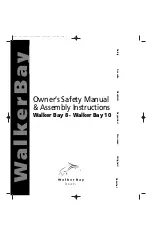
2021 OWNER’S MANUAL | Safety
9
are important factors in avoiding collisions which may cause
injury or death. When in doubt it is prudent to slow down within
adequate time and distance to be able to assess the conditions
and paths of other boats.
It is important to know the Rules of the Road, although do
not assume that all boaters also know the rules or that they will
abide by them. Avoid collisions by constantly assessing the ever-
changing situation and be sure to make appropriate speed and
course changes early.
Passenger Safety
The operator of the boat is responsible for the safety of
the passengers, all skiers/riders, as well as his/her own safety.
Ensure that you and your passengers adhere to these safety
recommendations:
• Any time you take your boat out, make sure that there is at least
one other passenger aboard who is familiar with the operation of
your boat.
• Ensure that all passengers are properly and securely seated in
appropriate seating locations to avoid falling or falling overboard.
• While the engine is running, and while the boat is maneuvering, all
occupants should be properly seated.
DO NOT
stand while the
boat is moving.
• DO NOT
sit on the engine box, seat backs, transom seating, sun
pad, boarding platform, or gunnels while the boat is underway.
You could fall overboard and be hit by the propeller, or another
boat.
• DO NOT
allow objects, arms or legs, or any other body parts to
hang over the bow or gunnels. Stay within the boat.
• Passengers should not sit in locations that obstruct the
operator’s visibility.
• Persons and gear should be stowed in a way that distributes
weight appropriately and in a manner that trims the boat
properly (pitch angle). Excessive weight at either the bow or the
stern relative to one another can cause trim problems leading to
reduced driver visibility, erratic steering, loss of control, or bow
submergence, and flooding/swamping.
• Passengers should be familiar with all emergency equipment and
instructed in its use.
• Passengers should assist with lookout duties and notify the
operator of any approaching watercraft or potentially unsafe
conditions to help with collision avoidance.
Carbon Monoxide Safety
Carbon Monoxide (CO) is a deadly, colorless, and odorless
gas produced by all engines and fuel-burning appliances. Even
with the best boat design and construction, plus the utmost
care in inspection, operation, and maintenance, hazardous levels
of carbon monoxide may be present in or near the boat under
certain conditions. The boat owner, operator, as well as all boat
occupants, must understand the dangers of carbon monoxide
and must comply with all safety recommendations/requirements.
For boats with cabins, always ventilate the boat interior and avoid
boating situations which cause increased exposure.
• DO NOT
allow people to be on or near the swim platform
or in the water near the swim platform while the engine is
running. CO will exist around the back of the boat when
engines are running.
• DO NOT
operate the engine in a confined space or while the
boat is tethered to another vessel.
• DO NOT
go under the boat cover while the engine is running
or shortly after the engine has been running. Carbon
monoxide may be trapped under the cover. It is important
to remove the cover and/or ventilate the area before going
under the boat cover.
• DO NOT
“platform/teak” surf or platform drag. CO will exist
in high concentrations in the vicinity of the swim platform
near the water while the engine is running. The USCG has
deemed platform dragging as a dangerous and hazardous
activity which should be prohibited, as it can result in injury
or death.
• Should someone exhibit the symptoms of CO exposure
(nausea, headache, dizziness, or drowsiness), have them
breathe fresh air and, if necessary, immediately seek medical
attention.
Hazardous boating situations involving carbon monoxide
include:
Blockage of boat exhaust by obstruction
Exhaust traveling along obstruction
DANGER
!
Carbon monoxide (CO) can cause brain damage or death. Engine and
generator exhaust contains odorless and colorless carbon monoxide
gas. Carbon monoxide will be around the back of the boat when
engines or generators are running. Move to fresh air, if you feel
nausea, headache, dizziness, or drowsiness.
Summary of Contents for RESPONSE TXi 2021
Page 1: ...OWNER S MANUAL 21...
Page 2: ...This page has been intentionally left blank...
Page 4: ......
Page 14: ......
Page 15: ...2021 OWNER S MANUAL Safety 1 SAFETY...
Page 29: ...2021 OWNER S MANUAL Safety 15...
Page 42: ...28 Safety 2021 OWNER S MANUAL...
Page 66: ...52 Quick Reference Guide 2021 OWNER S MANUAL...
Page 67: ...2021 OWNER S MANUAL Dashes Video Screens 53 DASHES TOUCH SCREENS...
Page 94: ...80 Dashes Video Screens 2021 OWNER S MANUAL...
Page 95: ...2021 OWNER S MANUAL Engines Drive Trains 81 ENGINES DRIVE TRAINS...
Page 108: ...94 Engines Drive Trains 2021 OWNER S MANUAL...
Page 109: ...2021 OWNERS MANUAL How It Works 95 HOW IT WORKS...
Page 130: ...116 How It Works 2021 OWNERS MANUAL...
Page 131: ...2021 OWNERS MANUAL Trailers 117 TRAILERS...
Page 146: ...132 Trailers 2021 OWNERS MANUAL...
Page 147: ...2021 OWNER S MANUAL Get Ready 125 GET READY...
Page 154: ...132 Get Ready 2021 OWNER S MANUAL...
Page 155: ...2021 OWNER S MANUAL Care Maintenance 133 CARE MAINTENANCE...
Page 174: ...152 Care Maintenance 2021 OWNER S MANUAL...
Page 176: ...154 Care Maintenance 2021 OWNER S MANUAL...
Page 177: ...2021 OWNER S MANUAL Warranty 155 WARRANTY...
Page 178: ...156 Warranty 2021 OWNER S MANUAL...
Page 191: ...2021 OWNER S MANUAL Warranty 169 Date Date Date Date Date Date Date Date...
Page 200: ...This page has been intentionally left blank...
Page 202: ......
















































